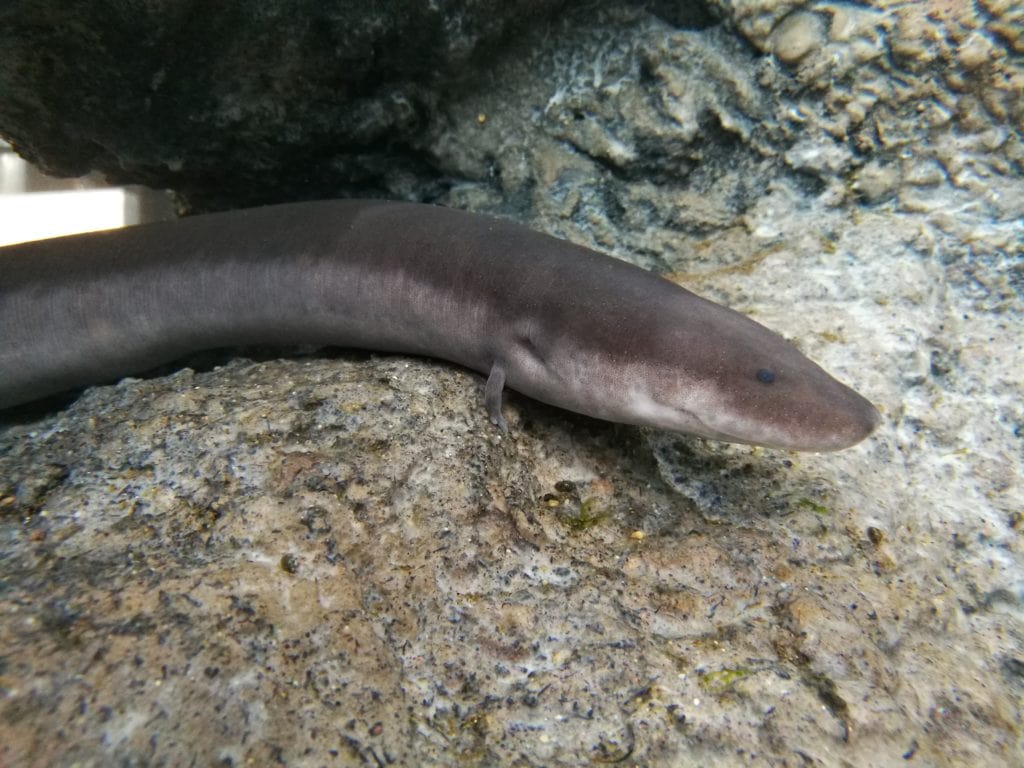Amphiumidae

The family Amphiumidae is comprised by a single extant genus, the Amphiuma, with 3 species. They are members of the suborder Salamandroidea, which includes all internally-fertilizing salamanders. Due to their unique characteristics, they have been previously separated in their own suborder, but most analyses reject this division, placing the Plethodontidae as their closest, although still very distant, relatives.
Amphiuma can resemble members of the family Sirenidae, with their large, aquatic and eel-like bodies, but they are easily distinguishable by the lack of external gills, and the presence of 4 reduced limbs.
These salamanders are native of the Eastern North America, they have large bodies, reaching up to 1 meter in length. Their tail is laterally compressed, making up one third of their length, and they are paedamorphic, preserving larval features such as the lack of eyelids and tongue, open spiracle, a lateral line system and four internal gill arches. They have both pairs of limbs, but while these are large and used for walking in larvae, they are highly reduced in adults and decrease in functionality as the animals grow, to the point of being difficult to discern. These salamanders are mostly aquatic, leaving the water only on humid nights to feed or reach new bodies of water. When their body of water goes dry, they are able to form a mucus cocoon in the mud that keeps them moist until their body of water becomes full again. They have been known to survive up to 3 years without food, and live up to 27 years.
The 3 extant species of Amphiuma are interestingly named after their number of toes.
- The one-toed specie (Amphiuma pholeter) is the smallest, reaching 25 cm and having only one toe on each limb
- The two-toed specie (Amphiuma means) is the largest, reaching 116 cm and it has been observed foraging on land on rainy nights
- The three-toed specie (Amphiuma tridactylum) also reaches the meter in length and it has the most toes on each limb, three
The two and three toed species are known for their unusually strong bite for a salamander, and should be handled with care.
Breeding behaviour has been observed in three and two-toed amphiumas. In Amphiuma tridactylum, the vitellogenic process takes almost a full year, indicating that the females lay eggs every two or more years, even though it is possible that in optimal condition the breeding cycle is shorter. Fertilisation is internal, occurring between January and April, after which the females lays an average of 201 eggs (clutch size varies between 44-282 eggs, depending on body size). The females guard the eggs in the nest until hatching in November.
Amphiuma create their nests and lay their eggs in dried out areas near bodies of water. This gives them the advantage of being able to live in environments that do not have constant water bodies, but with the downside of a more variable mortality rate. In the case of Amphiuma means, nests have been found up in dried out areas of lakes up to 100 m from the nearest remaining water, and 50 cm below surface. Similarly to other aquatic species which lay eggs on land, hatching seems to be triggered by inundation, with eggs hatching between 24 to 48h after the egg chamber has been inundated. The larvae have gills at birth, but quickly lose them, ending the larval period after roughly 14 days. A potential risk of this breeding strategy is that either there may be a longer dry period, in which case the eggs don’t receive the trigger to hatch, or there is a small flooding, which causes enough water to fill the egg chamber, but not enough for the larvae to leave it and reach a bigger body of water. In case of only a temporary flooding, larvae have been documented to survive without food for several months, with the longest recording of a hatchling surviving without food being 175 days. This is due to large yolk, which ensures survival until there is enough water to let the hatchling reach the main body of water. In case of delayed inundation, eggs have been recorded to survive up to 100 days on moist substrate, and in some cases hatch without the water trigger. Larvae that hatched out of water were able to survive on average 21 days without water (ranging from 1 to 91 days). Interestingly, the same experiment showed that for eggs that were left out of water for longer period (139 days) were able to hatch larvae that had reabsorbed the gills, and skipped the larval period altogether. This incredible plasticity allows for the best chance of survival of the hatchling, but it is necessary to remember that mortality highly increases the longer the eggs stay without water, with eggs that have been inundated early on having the highest survival rate.
Species List
Genus Amphiuma (3 species)
Amphiuma means
Amphiuma pholeter
Amphiuma tridactylum
References
Citation: Gunzburger, M. S. (2003). Evaluation of the hatching trigger and larval ecology of the salamander Amphiuma means. Herpetologica, 59(4), 459-468.
Citation: Fontenot Jr, C. L. (1999). Reproductive biology of the aquatic salamander Amphiuma tridactylum in Louisiana. Journal of Herpetology, 100-105.
Citation: AmphibiaWeb: Information on amphibian biology and conservation. [web application]. 2019. Berkeley, California: AmphibiaWeb. Available: https://amphibiaweb.org/. (Accessed: 2019).
Citation: Larson, Allan. 1996. Amphiumidae. Amphiumas. Version 01 January 1996 (under construction). http://tolweb.org/Amphiumidae/15440/1996.01.01 in The Tree of Life Web Project, http://tolweb.org/